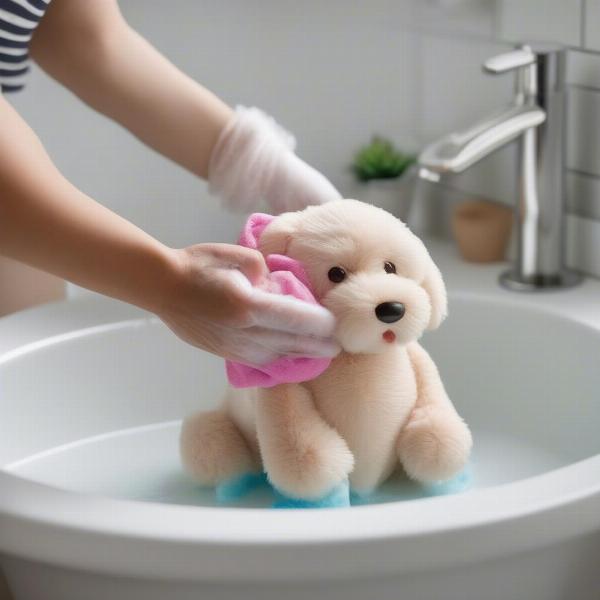A dog’s lovey, whether it’s a worn-out plush toy, a fuzzy blanket, or even an old sock, plays a significant role in their emotional well-being. For many dogs, a lovey provides comfort, security, and a sense of familiarity, much like a child’s favorite stuffed animal. This article delves into the world of dog loveys, exploring why they’re important, how to choose the right one, and how to care for them.
Why do dogs become attached to loveys? The simple answer is comfort. Loveys often provide a soft, tactile sensation that can be soothing, particularly for puppies adjusting to being away from their mothers and littermates. The scent of a lovey can also be a source of comfort, reminding them of their familiar surroundings. This can be especially helpful during stressful situations like thunderstorms, fireworks, or visits to the vet. For some dogs, a lovey can even aid in alleviating separation anxiety.
Choosing the Right Lovey for Your Dog
Selecting the perfect lovey involves considering your dog’s individual personality and preferences. Some dogs prefer soft, plush toys, while others gravitate toward textured fabrics or rubber toys.
-
Size and Durability: Choose a lovey that’s appropriately sized for your dog. Avoid toys that are too small and pose a choking hazard, especially for puppies. Durability is also key, particularly for dogs who are prone to chewing. Look for toys made from strong, non-toxic materials.
-
Material: Consider the texture and material of the lovey. Some dogs enjoy soft, plush fabrics, while others prefer textured or rubbery surfaces. Always opt for materials that are safe for your dog and easy to clean.
-
Scent: Some dogs are drawn to scented toys, while others are not. If you’re considering a scented toy, ensure the scent is derived from natural, non-toxic ingredients.
Caring for Your Dog’s Lovey
Just like any other dog toy, loveys require regular cleaning to maintain hygiene and prevent the build-up of bacteria.
-
Washing: Most plush toys can be machine washed on a gentle cycle. Always check the manufacturer’s instructions for specific cleaning recommendations. For non-washable toys, spot cleaning with a pet-safe cleaner is recommended.
-
Drying: Allow the lovey to air dry completely before returning it to your dog. Avoid using a dryer, as high heat can damage the toy.
-
Repairing: If your dog’s lovey becomes damaged, repair any tears or holes promptly to prevent further damage and potential ingestion of stuffing or small parts.
 Cleaning dog lovey
Cleaning dog lovey
When a Lovey Becomes a Problem
While loveys can be beneficial for dogs, there are instances where they can become problematic. Excessive attachment to a lovey can sometimes hinder a dog’s socialization or lead to anxiety if the lovey is ever lost or damaged.
-
Over-dependence: If your dog becomes overly dependent on their lovey, it’s important to encourage independence by gradually reducing their reliance on it. This can involve introducing other toys and activities to divert their attention.
-
Aggression: Some dogs may become possessive or aggressive over their loveys. If this occurs, seek professional guidance from a certified dog trainer or veterinarian behaviorist to address the underlying issue.
Conclusion
A dog lovey can be a source of comfort, security, and companionship for your furry friend. By understanding why dogs develop attachments to loveys and choosing the right one, you can provide your dog with a valuable tool for emotional well-being. Remember to prioritize safety, hygiene, and monitor your dog’s relationship with their lovey to ensure a healthy and balanced attachment.
FAQ
-
What is a dog lovey? A dog lovey is typically a soft toy or blanket that a dog forms a strong attachment to, providing comfort and security.
-
Why do dogs need loveys? Loveys can help dogs cope with stress, anxiety, and transitions, especially during puppyhood or in new environments.
-
How do I choose a good lovey for my dog? Consider your dog’s size, chewing habits, and preferences for texture and material.
-
How often should I wash my dog’s lovey? Regular cleaning, at least once a month, is recommended to maintain hygiene.
-
What if my dog becomes too attached to their lovey? Encourage independence by gradually reducing their reliance on it and introducing other toys and activities.
-
Can a lovey help with separation anxiety? While a lovey can offer some comfort, it’s not a substitute for professional help for severe separation anxiety.
-
What should I do if my dog becomes aggressive over their lovey? Consult a certified dog trainer or veterinarian behaviorist to address the possessive behavior.
ILM Dog is a leading online resource for dog owners worldwide, offering expert advice on dog breeds, health, training, nutrition, grooming, and more. We are dedicated to providing reliable, practical information to help you provide the best possible care for your canine companion. From choosing the right breed to understanding your dog’s behavior, ILM Dog offers a wealth of knowledge to empower you on your dog ownership journey. Contact us at [email protected] or +44 20-3965-8624 for personalized guidance.